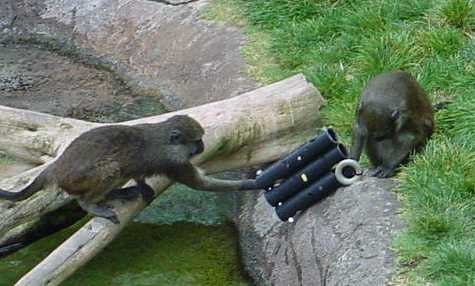
Manufacture, Selection, and Responses to Habitat Enrichment Items for Captive Nonhuman Primates
 |
Mary Baker, Ph.D.; Anthropology, UC Riverside
Students in ANBI 148: Heather Atchison, Nicole Barger, Noelle Bowlin, Katie Davis, Alex Dixson, John Early, Sarah Ferran, Erin Guth, David Hurne, Jaime Hessel, Katie Innes, Summer Keller, Miranda King, Rachel Maloney, Morgan Messing, Nellie O’Neill, Michelle Richardson, Milena Shattuck, Anna Skolnick, Christine Slocomb, Erin Smith, Jaima Smith, Kate Teffer, and Tricia Young; University of California, San Diego
INTRODUCTION
Keepers of captive primates are faced with the daily challenge of making the animals’ lives interesting.
The kinds of enrichment that are interesting to one species may not be of interest to other species; e. g., Colobus Monkeys, which have limited manual dexterity and attention spans are less likely to be attracted to puzzle boxes in the way that orangutans might be.
Selection of enrichment materials should be informed by an understanding of the animal’s ranging pattern, foraging strategy and activity patterns.
Individual variation in interest is also an important consideration: sex, age, life experiences, and personality can have an impact on enrichment preferences.
The research projects presented herein used a variety of enrichments, all groups received at least one puzzle feeder (Bolt or S-feeders), and the rest of which were selected according to foraging strategies and activity patterns.
METHODS
There were five projects, focusing on eight primate species, housed at the San Diego Zoo, California.
Three species were housed in single-species exhibits:1. Angolan Colobus (Colobus angolensis palliates)
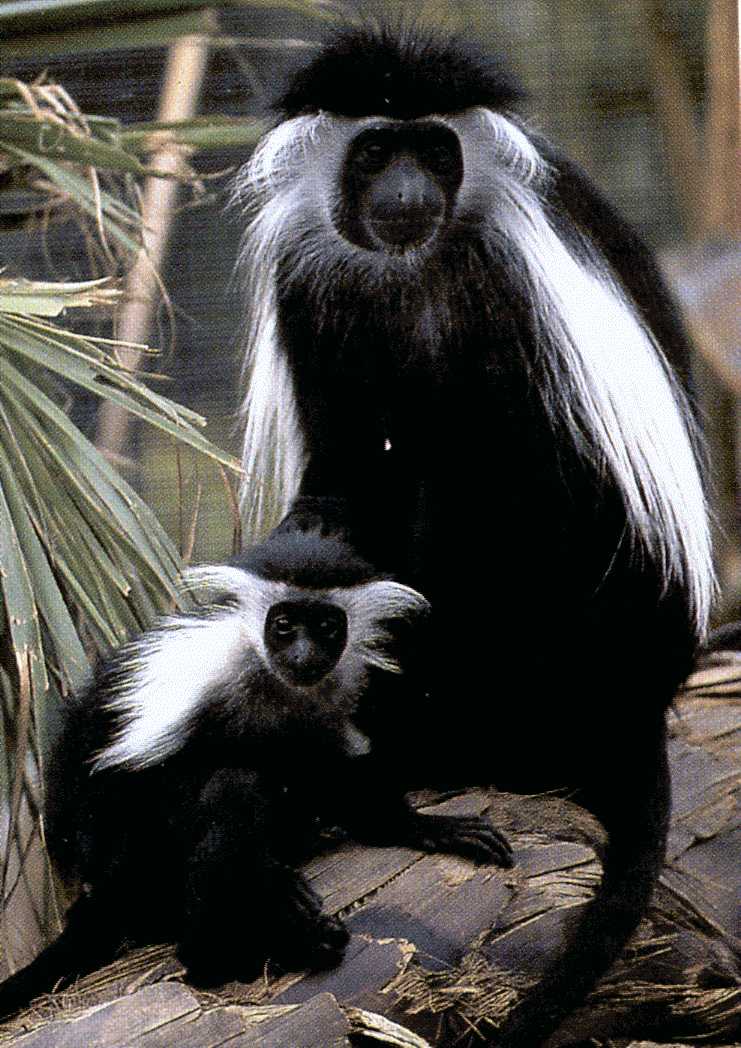
The primary goals were to find enrichments that would encourage use of the entire exhibit, to foster more arboreal behaviors and to find things that didn't scare them.
They received 2 Browse feeders, 2 S-Feeders, and 1 free-standing tube
2. Golden Bellied Mangabeys (Cercocebus agilis chrysogaster)
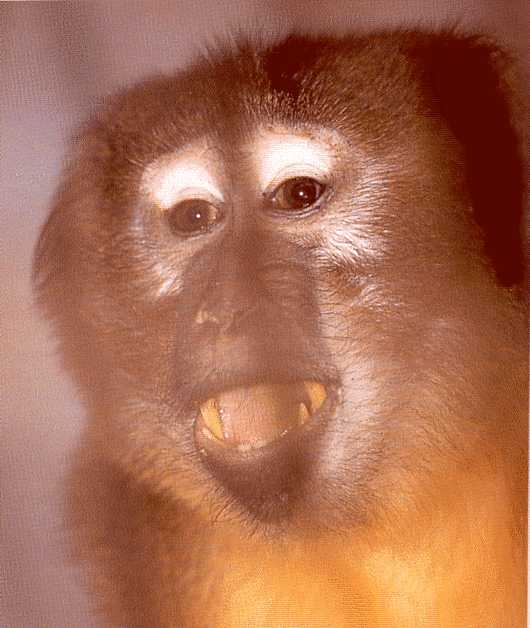 The
primary goals were to reduce self-directed aggression and threat displays
directed at zoo visitors. We also wanted to get them up and moving and to
find enrichments that would hold their attention.
The
primary goals were to reduce self-directed aggression and threat displays
directed at zoo visitors. We also wanted to get them up and moving and to
find enrichments that would hold their attention.
They were given 2 Drums, 1 rattle, 1 tube with ball, one T-ring toy, and 1 Bolt feeder.
3. Gelada baboons (Theropithecus gelada)
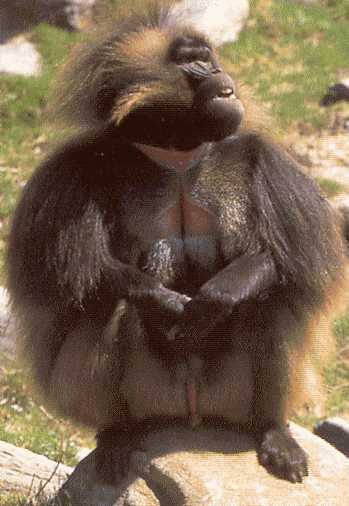
Here we were exploring differences in social and foraging styles of enrichment.
The geladas were given 1 Bolt feeder, 1 mirror, 2 tubs with water and food frozen in ice blocks
Two kinds of monkeys live in a multi-species exhibit, "The Ituri Forest" exhibit:
|
4. Allen’s Swamp Monkeys (Allenopithecus nigroviridis) |
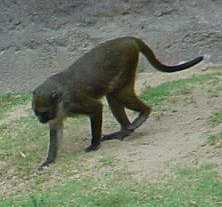 |
|
Schmidt’s Spot-nosed Guenons (Cercopithecus ascanius schmidti) |
|
In this enclosure we were looking at inter-species differences in foraging styles and win-stay vs. win-switch strategies.
We used 3 Bolt feeders and 3 S-feeders
Four species were housed in an off-exhibit area:
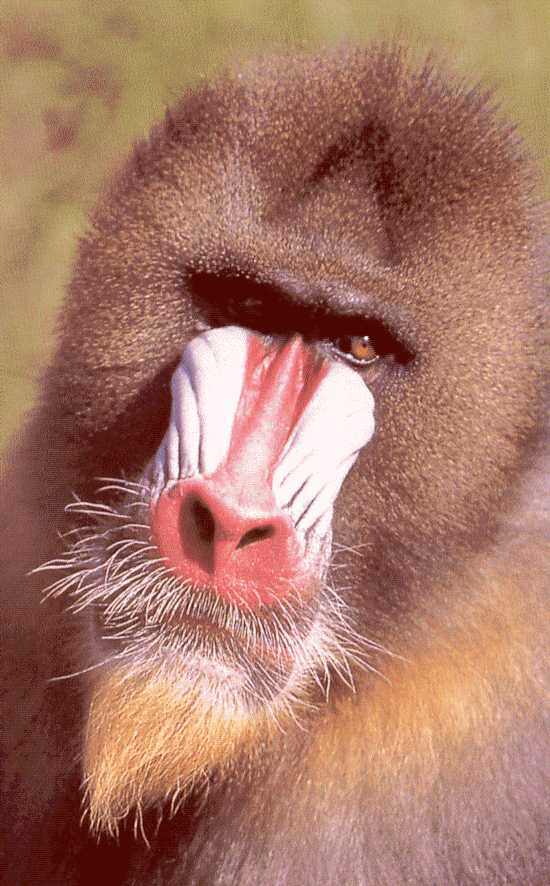
5. Mandrills (Mandrillus sphinx) |
(Cercopithecus neglectus) |
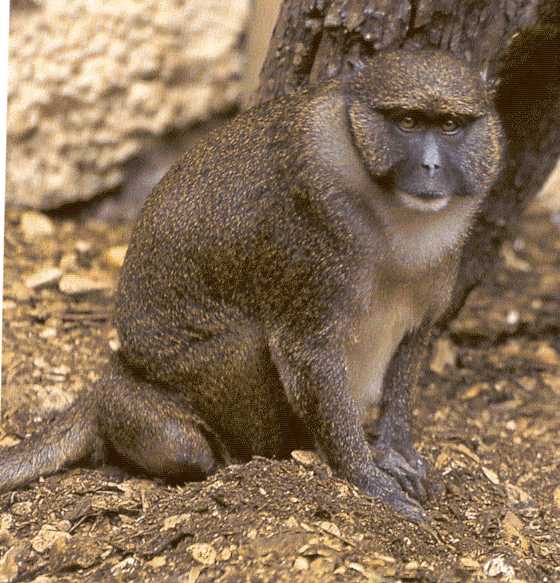
Allen's Swamp monkeys (Allenopithecus nigroviridis) |

Wolf’s Guenons (Cercopithecus wolfi) |
The goal here was to make the enclosures more interesting. We were also interested in the "spill-over" effect: would enriching one group also be enriching to adjacent groups? On some days all groups were enriched, on other days only the mandrills were enriched.
They were given food frozen in ice, hay with crickets, a puzzle toy, and 2 bolt feeders.
Data were collected between April 16 and May 30, 2002 at the San Diego Zoo.
Two weeks of base line data followed by three weeks of a mixture of enrichment and non-enrichment data were collected.
During baseline and enrichment weeks, data were collected following one of two protocols:
→ three days a week, skipping days between observation days, collecting data in the morning, just after the monkeys were let out of their night-rooms.
→ two days a week, once in the morning just after the monkeys were let out of their night-rooms and later the same day in the afternoon.
Two enrichments were supplied each week, separated by 1 -3 days, for a total of six enrichments.
Every group had at least one Bolt or S-Feeder (depending on the relative strength of the feeder and species).
Additionally, groups received a variety of other enrichments including the other a commercially produced puzzle toy, a 1' x 4' mirror, hay with crickets (live or dead), food frozen in ice, large tubs of water, and/or a large free-standing PVC tube.
| Undergraduate Heather Atchison sands the holes drilled into S- and bolt feeders. |  |
White PVC and Black ABS pipe were used to make a variety of enrichment items.
Click here for images and instructions on how to make them.
Two types of puzzle feeders
A long tube with a ball inside of it
A tube and a "T" shaped structure with rings that could be manipulated
Rattles and Drums
A free-standing tube to play on and in
RESULTS
All groups except the Gelada baboons showed great interest in the puzzle feeders and other forms of enrichment.
Among the Off-Exhibit Groups, a comparison of enrichment totals across all species showed significance in a chi squared test (p < 0.0001), indicating that while the enrichment was enriching to all, it’s effect on their behavior patterns differed among species. A chi square test revealed significant changes in behavior for the Wolf, Allen’s, and DeBrazza’s guenons on spillover days (p < 0.0001), indicating that enrichment in one group can be enriching for adjacent groups.
The Mandrills used the feeders within the first two minutes of their introduction. The male tossed the ice blocks up on the air and against the wall. They rested, fed, and went out-of-sight less often and engaged in more object manipulation on enrichment days.
The DeBrazza's Monkeys rested and fed less and showed an increase in object manipulation and general activity during enrichment. The spill-over effect resulted in less time resting, feeding and out-of-sight and more time being active.
The Allen's Swamp Monkeys rested and fed less and showed an increase in object manipulation during enrichment. The spill-over effect resulted in less time resting and feeding.
The Wolf Guenon rested and fed less often and engaged in more object manipulation and spent more time manipulating objects, was more active and spent more time out-of-sight on enrichment days. The spill-over effect resulted in less time resting and feeding and somewhat less time engaged in human- and self-directed behaviors.
 |
Species-level comparisons of activities on days when all groups were enriched.
Self = Self directed Human = Human directed Out = Out of sight |
All of the singly housed species showed interest in at least one of their enrichment items.
The Mangabeys showed initial mild alarm, but made contact with in the first five minutes. Although the differences were not statistically significant, the general trend of the data indicated an overall decrease in aggression and stress related behaviors during enrichment periods. Interest in the enrichment decreased through the day, but the differences were not statistically significant. The Mangabeys preferred the tube with ball, the S-feeders, and anything containing food.
The Angolan Colobus Monkeys demonstrated avoidance for twenty minutes and were very cautious when first using the feeder. The three resident adults showed little interest in the feeders, interacting with only with the branch feeders containing browse a total of six times. The juveniles and sub-adults displayed a marked willingness to explore and utilize the enrichment objects, exhibiting a preference for the puzzle feeders twice that of the branch feeders. The freestanding tube was interacted with the least and was not recorded during the actual scans. This was, however, the one object that did seem to instigate some individual play-type behavior. The sub-adults and juveniles would occasionally sit on top of it, and then kick at it with their legs as they jumped away, making the tube roll along the ground.
The Gelada Baboons showed no interest in the feeders (they used one once) or food with ice, but they did drink from the tubs of water. They were not interested in the hay and crickets. The mirror, however, had a strong impact on the social dynamics of the pair. The male made lip flip and eyelid flash displays at the mirror and increased the number and range of his vocalizations. He would position himself at various points in the enclosure and peer around objects to gaze at the reflection in the mirror. The female was interested in the mirror, but the male began to herd her away from it. She looked at the mirror less frequently, although she was observed rapidly alternating her gaze between the mirror and the male. The mirror continued to have a powerful effect on the social dynamics even after its removal.
In the Ituri Forest the Allen's Swamp Monkeys and Spot-nosed Guenons used the feeders within the first two minutes of their introduction. The spot-nosed engaged in most of the feeder manipulations, probably because most of the feeders were mounted above ground (Allen's Swamp Monkeys are more terrestrial). Also important to note is that, in general, the Spot-nosed monkey group is younger and more dominant over the swamp monkeys. When the Swamp monkeys attempted to forage at the feeders, the adult male Spot-nosed monkey, Abu, aggressed at the Swamps, displacing them from the feeders. However, on enrichment days the Swamp Monkeys were able to increase their time spent foraging elsewhere
 |
ACKNOWLEDGMENTS: We thank the San Diego Zoo and Head Mammal Curator, Karen Kilmar for allowing us to conduct this research. The following keepers provided invaluable information, assistance and enthusiasm: Ituri Forest: Rochelle Willison, Lisa Bryant, John Michel, and Megan Sundeen; Angolan Colobus Monkeys: LeAnn Anderson, Michael Bates, and Kim Livingstone; Mammal Holding: Sue Averill, Kim LeMier, Nerissa Murray, Debbie Blue, and Sarah Cuellar; Gelada Baboons: Lisa Bryant, Jen, Mary, Joanne, and Lori; Mangabeys: Kim Livingstone, Michael Bates, and Cherie Davis. Burl, with the construction company of Rudolf and Sletten kindly donated the green PVC pipe to the Colobus project.